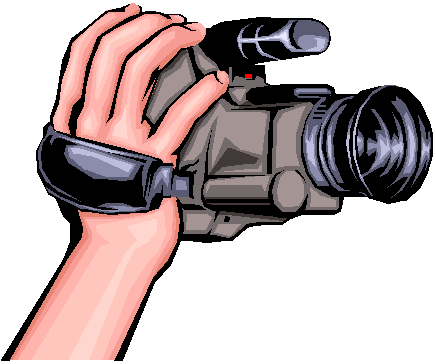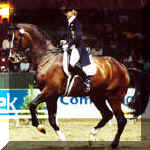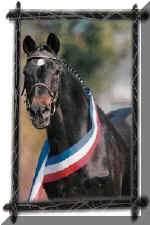|





| |
Cor de la Bryère


Foaled 1968, France
Imported to Holstein, Germany, 1971
Height 16.21/2
Stood at Siethwende from 1971 to 1984, Zangersheide 1985, Elmshorn 1986 to 1988,
Sollwittfeld from 1989 until his death in 2000
|
|
|
|
Foxhunter
|
|
|
|
Foxlight
|
Chonia
|
|
|
Rantzau
xx
|
|
Chavallise
d'Ar
|
|
|
|
Rancune
|
Rockella
|
|
Cor
de la Bryère
|
|
|
|
|
|
|
|
Furioso
xx
|
|
|
|
Lurioso
|
Riquene
|
|
|
Quenotte
|
|
Landau
|
|
|
|
Margot
|
Kristine
du B.M.
|
Cor de la
Bryère is the stallion that revolutionised jumping horse breeding. His is the
name astute breeders like to see, especially on the mare line for ‘Cord’
tends to give great form over a jump.
His sire – the French Thoroughbred, Rantzau, was bred to be a jumper being a
descendent of the enormously influential Bay Ronald. Rantzau was by Foxlight by
Foxhunter by Foxlaw by Son-In-Law by Dark Ronald by Bay Ronald.
A serious racehorse, Rantzau was third ranked three year old of his year - in
nine races between 2000 and 3000 metres, he won two and was placed five times.
Purchased by the National Stud, he arrived at the stallion depot of Saint-Lô on
January 5th, 1951.
Of Rantzau, the stud inspector noted: ‘good front extension, remarkably built
through the shoulder and fore-arm, long haunches, this classy stallion of rare
nobility, also has low-placed joints and covers ground'.
Contrary to legend, the breeders in the area were quite enthusiastic about this
well-bred, well-conformed and well-performed newcomer and between 1951 and 1962,
he bred between 40 and 49 mares a year. In those days French state stud
stallions were only allowed to breed 40 mares a year, plus the National Stud
director’s cards used by him ‘in the interest of breeding’. In 1971 he
covered his last book of mares, with five foals the result. In twenty years of
breeding he covered 772 mares at an average of 38 mares a year for 179 fillies
and 194 colts. His fertility of 50% was regarded as normal for the time.
By 1964, Rantzau had moved into 3rd place on the ranking of aged sires of
jumping horses, behind Lutteur B and Kenavo D, and the next year he moved into
2nd place with progeny jumping with success all over Europe, and held that
second place until 1969. In 1970 he moved down to third place behind Ibrahim and
Furioso, but the next year he moved into first place on the jumping rankings, as
well as being in 5th place on the sire of eventers rankings - he was even
ranking in the 20s as a sire of dressage horses.
As late as 1976, when he had been dead for five years, Rantzau was still 3rd on
the jumping sires rankings, by 1980 he had moved into 4th place. He remained for
many years one of the leading sires of broodmares.
On the bottom side, Cor de la Bryère was royally bred, out of Quenotte B, by
Lurioso a son of the most influential Precipitation son, Furioso. In French
jumping circles, Furioso had been a sensation, siring the 1964 Olympic gold
medallist, Lutteur B and the world showjumping champion of 1968, Pomone B.
Lurioso was himself a sire of international showjumpers.
Cor de la Bryère almost never made it to the breeding barn. In 1970, the
selection committee of the Haras du Pin visited his owner, Xavier Ribard and
suggested ‘that is not breeding stock, he’s too much of a sport horse.
Better geld him; he’ll make a useful gelding.’
The horse was now on the market – and it just so happened that the Holstein
Association was looking for French blood, having seen the success of Furioso II
and Futuro in Oldenburg. Oldenburg breeder (and showjumping ace) Alwin Schockemöhle
was looking for a stallion star, and leased the Furioso xx son Urioso –
however he was prepared to sub-lease the stallion to the Holstein Verband. Hence
a Holstein inspection committee travelled to France to evaluate Urioso and in
doing so, discovered Cor de la Bryère. Urioso ended up standing two forgettable
seasons in Holstein while ‘Cord’ left an indelible mark on the Holstein
breed, and jumping the world over.
He was not only a sire himself but a sire of sires. The full brothers, Caletto
I, II and III were stars, as were the brother quartet of Calypso I to V. In the
jumping arena, his handsome grey son, Corrado has been a star for Franke
Sloothaak, while Cordalmé Z with Gilbert Böckmann has also been successful at
international level.

Cor de
la Bryere progeny continue to shine - at the 2001 European Showjumping champs,
the Cor de la Bryere son, Broere VDL Corland, led the competition going into the
final day. Corland is pictured here with his rider, Wout-Jan van der Schans
In his first season, Cor de la Bryère covered 70 mares at Siethwende and four
colts from his first crop were licensed.
He was a stallion of great vigour, and as late as 1977 served a full book of 111
mares.
Although best known as a sire of jumping horses, Cor de la Bryère was also the
sire of Corlandus, a World Cup Dressage Champion in 1989, and his sons Calypso I
and Calypso II have proven a useful sire of dressage horses. Current German
Olympic team member, Chacomo ridden by Alexandra Simons de Ridder is by Calypso
I, as was Alexandra’s other FEI star, Champus.

Cor de
la Bryère's most successful dressage horse - Corlandus
In
Australia the influence of Cor de la Bryère has been strong through his son,
Contact imported in 1976. Although subject to a vicious campaign of vilification
by established breeders (with stallions of their own), Contact produced a number
of international level competitors: Corroboree (Grand Prix dressage) and the
showjumper, Talkind, ridden by Colleen Brook at the first WEG in Stockholm in
1990, and sold on to Italy. The Contact son, Northern Congress is the sire of
Australian Grand Prix champion and World Cup representative Charisma.
Calypso
Classic (by Calypso II) was imported by Barbara Burrows, and after quite a
successful dressage career, he has now gone showjumping. In Western Australia,
Barrabadeen Stud imported two own daughters of Cor de la Bryère.
More recently, two offspring of the Calypso II son, Carbid – the stallion
Carbine and the mare, Cinderella, have been imported. Carbine has been a
finalist at the Australian Young Horse Championships, while Cinderella won the
five year old title in 2000.
In the latest WBFSH ratings, Cor de la Bryère is ranked 18th with 28 points
earning progeny, but there are a staggering 20 own sons on the rankings: Calando
I, II, IV; Caletto I, II; Calvados I, II; Calypso I, II, III; Cantares, Carneval,
Carte d'Or, Casanova, Cavalier Royale, Cinzano, Constant, Contact, Corrado I,
Cortez 679, Cosinus. There are also 12 grandsons of Cor de la Bryère in the
standings - not to mention important stallions like Cathago Z and Burggraaf -
who are out of Cor de la Bryère mares.

Here is
Romedio Graf von Thun-Hohenstein in his book, The Holsteiner Horse,
commenting on Cor de la Bryère's shape over a jump:
'When the goal was to join the exciting powerful jumping ability of the
Holsteiner with a sophisticated skill, combined with an ideal bascule, sooner or
later a stallion such as Cor de la Bryère had to be selected. The arching back,
like a taut band of steel combined with the super elastic end gives limitless,
but always expedient, springing capability to the natural dynamics of each
effort. Add to that ease of riding, marvelous disposition, and a floating,
highly balanced canter. These qualities are absolutely to the benefit of young
horses, who will no longer have to pay with premature breakdowns caused by
jumping and showing solely with a raw, crude jumping talent.'
And
perhaps it was a case of a stallion being in the right place at the right time -
French equestrian journalist, Bernard le Courtois is firmly convinced, that left
in France, Cor de la Bryère would have simply confirmed the original assessment
of the French selection committee:
According
to Bernard: “Some stallions cross very well in a particular situation.
For example, Cor de la Bryère.
He was exceptional in the 70s in
Holstein
because he was a horse that was very quick with the front legs. He did not have
the power on the back side, but he was a very electric horse, with the blood of
the Thoroughbred, Rantzau, and mixed with the heavy Holsteiner
mares, he was fantastic. But when we tried to breed Cor
de la Bryère with the French mares, we had rabbits.
Cor de la Bryère needed
a very strong mare, and we didn’t have this kind of mare in
France
.”


|

